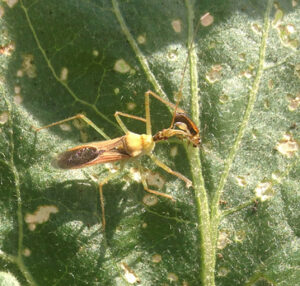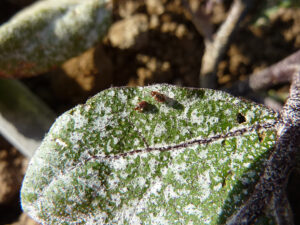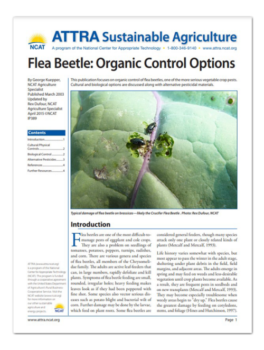Flea Beetle: Organic Control Options
By George Kuepper, NCAT Agriculture Specialist
Updated by Rex Dufour, NCAT Agriculture Specialist
Abstract
This publication focuses on organic control of flea beetles, one of the more serious vegetable crop pests. Cultural and biological options are discussed along with alternative pesticidal materials.
Introduction
Flea beetles are one of the most difficult-to-manage pests of eggplant and cole crops. They are also a problem on seedlings of tomatoes, potatoes, peppers, turnips, radishes, and corn. There are various genera and species of flea beetles, all members of the Chrysomelidae family. The adults are active leaf-feeders that can, in large numbers, rapidly defoliate and kill plants. Symptoms of flea beetle feeding are small, rounded, irregular holes; heavy feeding makes leaves look as if they had been peppered with fine shot. Some species also vector serious diseases such as potato blight and bacterial wilt of corn. Further damage may be done by the larvae, which feed on plant roots. Some flea beetles are considered general feeders, though many species attack only one plant or closely related kinds of plants (Metcalf and Metcalf, 1993).
Life history varies somewhat with species, but most appear to pass the winter in the adult stage, sheltering under plant debris in the field, field margins, and adjacent areas. The adults emerge in spring and may feed on weeds and less-desirable vegetation until crop plants become available. As a result, they are frequent pests in seedbeds and on new transplants (Metcalf and Metcalf, 1993). They may become especially troublesome when weedy areas begin to “dry up.” Flea beetles cause the greatest damage by feeding on cotyledons, stems, and foliage (Hines and Hutchinson, 1997).
In organic systems, the preferred approaches to pest management are those that enhance the diversity of the farm system, such as cover cropping, rotation, and interplanting; those that use special knowledge of pest biology, such as delayed planting; and those that take advantage of existing on-farm resources. These approaches are typified by cultural and biological controls, which will be discussed first. Alternative pesticides, while frequently necessary for some crop pests and conditions, can be treated as “rescue chemistry” to be used when and if other strategies fall short.
Cultural/Physical Controls
Flea beetles are favored by stable, warm spring weather and hampered by alternating periods of hot and cold temperatures with intermittent rains. Seedlings of crops are most vulnerable to flea-beetle feeding when stressed, particularly by inadequate moisture. Providing good nutrition and favorable growing conditions aids in shortening the vulnerable early-growth stages and helps plants survive flea-beetle attack. The literature suggests that organic fertilization may make crops less attractive to flea beetles (McKinlay, 1992).
Because the pest is so mobile, and because so many genera and species are involved, crop rotation, by itself, has little effect as a control strategy. However, living mulches or polycultures are known to reduce flea-beetle damage (McKinlay, 1992; Anon., 2000). One reason for this is that the individual crop plants are not silhouetted against a bare-soil background and are less obvious to the pest (McKinlay, 1992). The ATTRA publication Companion Planting & Botanical Pesticides: Concepts & Resources elaborates further on this subject.
Trap cropping, in which attractive plant species are planted near the main crop to draw the pest away, offers some possibilities for flea-beetle management. Apparently the most practical trap crop is Chinese Southern Giant Mustard (Brassica juncea var. crispifolia), seed of which is widely available. Research has shown that planting this trap crop about every 55 yards between rows of cabbage, broccoli, or cauliflower (or as a border around the field) can do an exceptional job of protecting them. To retain effectiveness, reseeding of the trap crop may be necessary, especially if the pest destroys the first planting. The trap is less effective in protecting crops that are almost as attractive to flea beetles as Giant Mustard is, such as Nappa cabbage, gai choy, and choy sum (Chaput, 1999).
Another approach to trap cropping is to interplant radishes—Chinese Daikon and Snow Belle are preferred by the pest—at 6- or 12-inch intervals among cole crops. In one trial, this measurably reduced damage to broccoli (Byczynski, 1999).
Row-cover materials such as Reema™ can be used to cover seedlings and provide a barrier to adult beetles. It is advisable to get the row cover in place at or before emergence for maximum protection. The covers can be removed once the pest population subsides (Ellis and Bradley, 1992). To be most effective, row covers should be used in conjunction with a planned crop rotation in which the crop to be protected follows a non-susceptible crop. This reduces the chance that pests will emerge under the row cover (Caldwell, 1998). ATTRA has additional information on row covers, including manufacturers and distributors, in the publication Season Extension Techniques for Market Gardeners.
Growers report some level of flea-beetle control using white and yellow sticky traps (Byczynski, 1999; Anon., 1996). Reference is made to individual traps placed every 15 to 30 feet of row. Encircling the field with continuous sticky tape is also mentioned. Sources of sticky traps include ARBICO and Golden Harvest Organics (see Further Resources).
Since the adults overwinter in plant debris, there is value in sanitation procedures that destroy refuge sites. Plowing or rototilling weeds and crop residues in the fall is often recommended, as is destruction of grassy and solanaceous (tomato family) weeds adjacent to the field (Flint, 1990). Unfortunately, these procedures are often in conflict with good sustainable practices that strive to maintain soil cover and field buffers. When such conflicts occur, growers can view sanitation procedures as transitional strategies only and look for more sustainable practices to use in the future.
Anecdotal reports have suggested that catnip might repel flea beetles. Research by organic gardeners in 1997 failed to confirm this information, however. The gardeners reported that catnip used as a mulch or sprayed as an extract tea did a generally poor job of repelling the pest (Long, 1998).
Biological Control
In healthy agroecosystems, there are populations of beneficial predators and parasites that work to control the number of flea beetles and other pests. One example is Microcotonus vittage Muesebeck, a native braconid wasp that kills the adult flea beetle and sterilizes the female flea beetle (Hines and Hutchinson, 1997). Growers can manage the diversity of their farms and gardens to support populations of beneficials. Specific information on such strategies is provided in the ATTRA publication Farmscaping to Enhance Biological Control.
Commercial formulations of entomopathogenic nematodes are effective agents for controlling flea beetles (Ellis and Bradley, 1992). Applied to the soil, the nematodes attack the beetle’s larval stage, reducing root feeding and helping to prevent the next cycle of adults from emerging. ATTRA’s Sustainable Pest and Weed Control Database has information about formulations of beneficial nematodes. Search in “Active Ingredients” under Steinernema or Heterorhabditis.

An assassin bug preying on a flea beetle, with typical flea beetle damage on eggplant leaf. Likely Western Potato Flea Beetle. Photo: Chris Hay
Alternative Pesticides
Botanical pesticides recommended for controlling flea beetles include neem, rotenone, pyrethrin, sabadilla, and formulations of these in some combination (Ellis and Bradley, 1992). The University of California mentions insecticidal soap as an organic option for flea beetles, but indicates that it “may provide partial control” only (Anon., 1997; Nielsen, 1997). Sprays combining rotenone with insecticidal soap are considered very effective (Flint, 1990). Other sources suggest that garlic sprays are useful (Rateaver and Rateaver, 1993). Research in Colorado showed that garlic extracts are successful in suppressing flea beetles, but efficacy may trail off later in the season (Anon., 1998). In addition to garlic, the USDA Natural Resources Conservation Service (NRCS) recommends onion and mint as natural flea-beetle repellants (USDA, no date).
Pyola™ is a natural insecticide product that combines canola oil with pyrethrins. It is recommended for use on flea beetles, cucumber beetles, Mexican bean beetles, squash bugs, aphids, mites, and Colorado potato beetle. However, since much of the canola oil on the market is derived from genetically engineered plants, this product may or may not be acceptable for organic production. Growers should contact their certifying agent before purchase and use. To learn more, visit Gardens Alive!
Botanical and soap-based pesticides should be considered a last resort in organic management. Like synthetic pesticides, most of these materials are broad-spectrum and kill many beneficial, non-target organisms, including predators and parasites that help keep the flea beetle population in check naturally.
Not a botanical and not often mentioned in this regard, diatomaceous earth has been observed to reduce flea-beetle populations and is sometimes recommended (Anon., 1999; Spring and Day, no date).

Flea beetles attempting to graze on eggplant leaf coated with Surround kaolin clay. Surround may provide some protection against flea beetle feeding. Photo: Rex Dufour NCAT
The kaolin-clay-based product Surround™ has undergone some preliminary evaluation for flea beetle control on eggplant. While effective in reducing flea beetle damage, Surround™ degraded fruit yield and quality; there also were problems removing the clay residue coating from the fruit. The use of this product will likely be limited to the early part of the season, before fruit set (Maletta et al., 2002).
Fields should be regularly monitored to determine if and when any pesticidal agents should be applied. This is especially critical with flea beetles, since a small population can do significant damage to a crop in the cotyledon or first-leaf stages. The University of California recommends that treatment begin when several damaged rows are observed, and that spot treatment of rows and borders be attempted first (Anon., 1997). Small growers, whose whole crop may comprise just a few rows, will need to act more quickly. Once cole crops reach the five-leaf stage, they are generally able to tolerate a moderate level of damage; older plants are even more tolerant.
Further Resources
Websites
Evaluating trap crops for controlling flea beetle in brassicas, and an organic pesticide trial. By Mary Scott. Organic Farming Research Foundation.
An overview of research that studied trap crops and their effectiveness for controlling flea beetles.
Flea Beetles. By W.S. Cranshaw. Colorado State University Extension.
Provides information on history and habits of flea beetles, as well as cultural and chemical controls.
Flea Beetles on Vegetables. By Center for Integrated Pest Management, North
Provides a useful profile of flea beetles, including their biology and habits, host plants, damage, distribution, and control.
Webinars
Diversity by Design: Using Trap Crops to Control the Crucifer Flea Beetle. By J. Parker and W. Snyder. 2014.
A webinar exploring the use of trap crops, stands of plants grown to attract pest insects away from target crops.
Suppliers
ARBICO
P.O. Box 4247, Tucson, AZ 85738-1247
Tel: 800-827-2847
Fax: 520-825-2038
E-mail: info@arbico.com
Golden Harvest Organics
404 N. Impala Drive, Fort Collins, CO 80521
Tel: 970-224-4679
Fax: 413-383-2836
E-mail: info@ghorganics.com
Flea Beetle: Organic Control Options
By George Kuepper, NCAT Agriculture Specialist
Published March 2003
Updated by Rex Dufour, NCAT Agriculture Specialist, April 2015
©NCAT
IP389
This publication is produced by the National Center for Appropriate Technology through the ATTRA Sustainable Agriculture program, under a cooperative agreement with USDA Rural Development. ATTRA.NCAT.ORG.


